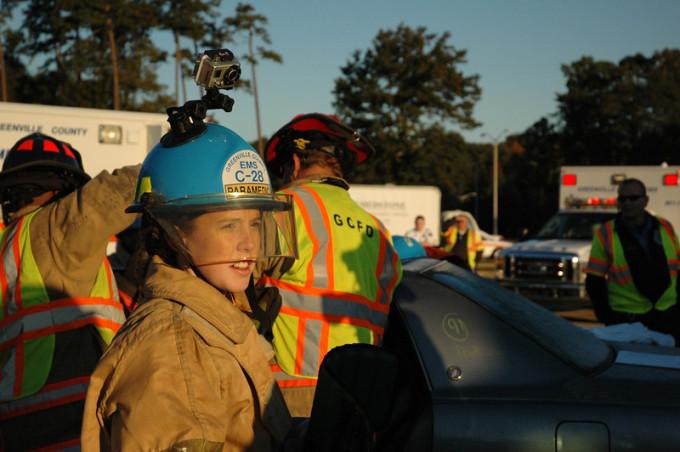
Get the latest articles delivered directly to your inbox!
Our Contributors
Class of 2022
Kyle Duke
Austin Foster
Charlotte Leblang
Ross Lordo
Class of 2021
Dory Askins
Connor Brunson
Keiko Cooley
Mason Jackson
Class of 2020
Megan Angermayer
Carrie Bailes
Leanne Brechtel
Hope Conrad
Alexis del Vecchio
Brantley Dick
Scott Farley
Irina Geiculescu
Alex Hartman
Zegilor Laney
Julia Moss
Josh Schammel
Raychel Simpson
Teodora Stoikov
Anna Tarasidis
Class of 2019
Michael Alexander
Caitlin Li
Ben Snyder
Class of 2018
Alyssa Adkins
Tee Griscom
Stephen Hudson
Eleasa Hulon
Hannah Kline
Andrew Lee
Noah Smith
Crystal Sosa
Jeremiah White
Jessica Williams
Class of 2017
Carly Atwood
Laura Cook
Ben DeMarco
Rachel Nelson
Megan Epperson
Rachel Heidt
Tori Seigler
Class of 2016
Shea Ray
Matt Eisenstat
Eric Fulmer
Geevan George
Maglin Halsey
Jennifer Reinovsky
Kyle Townsend
Join USCSOMG students on their journeys to becoming exceptional physician leaders.

Out of the Classroom and into Disaster!
After three months of training, I am officially certified as a basic emergency medical technician (EMT). For the last three months, my classmates and I have been learning the skills of assessment, bandaging, and immobilization (preventing movement of the spine) of injured patients. We have been trained to respond to a variety of disasters where human life is at stake. Today, our EMT skills are being put to the test.
The culmination of our Emergency Medical Technician (EMT) certification training is a full-scale simulated disaster drills with two scenarios, a car crash and shooting incident. The full-scale, true-to-life disaster training exercise involves Greenville County firefighters, EMS and police, as well as med school faculty and staff. Both scenarios are very real. As first responders, my classmates and I must address each situation as healthcare professionals. Our adrenalin is pumping full blast.
At 7:45 a.m., my classmates and I report to our medical school building and then jog to the accident scene to experience a vehicle wreck extrication and rescue. I see the two cars, metal melded together at the front. The windshields crackle with spider web-like patterns. Doors are crunched in, never to open normally again. I don my fireman coat, hat and gloves, as the scene could be dangerous. As my team and I approach the vehicles, we ask ourselves, “Whose lives will we be fighting for?”
Fire truck sirens go off in the distance, and they speed toward the wreck. Firefighters jump out, prepared to do their work with the “jaws of life,” massive cutting tools designed to take apart vehicles. Glass crackles and metal is bent and broken; I can see a patient’s hand slapping the window. Meanwhile, my team checks out a patient who’s been ejected from the vehicle. The patient is breathing, and we package him up into a car seat and send him away on an ambulance.
We move to the patients in the car. Other EMTs are designated to take care of the patients in the front seat, while my team is responsible for a woman in the back screaming for her child, which is nowhere to be seen. (The child, a mannequin, was ejected from the car.) As we work, I try to do my best to comfort the agitated woman without giving her false hope. “Your baby is at the hospital now, and being taken care of.” I said. After 10 minutes of struggling, we managed to get her out of the car. She’s of average height and weight, but too heavy for my female partner and me to get out by ourselves. She’s got a broken femur and is screaming in pain; there’s also the risk of a spinal injury and head contusion. Despite the cold October morning air, I’m sweating under my coat. My heavy gloves make it difficult to complete my tasks. I’ve got EMTs, firemen and patients crowding the car. I have to ignore these distractions and focus on the task of getting my patient into an ambulance and saving her life.
My teammates and I put the woman into a KED. A Kendrick Extrication Device (KED) is a tool used to immobilize a patient’s spine when they are in a vehicle or sitting and need to be moved. In a chair, it’s fairly easy to supply such a device, but in an enclosed car surrounded by other students and dangerous metal, it’s tough to get a patient strapped in. We managed to (incorrectly) get her into the KED and moved her to a spine board to put her on a stretcher. We have difficulty moving her, and she is screaming about her femur fracture. Next we put a traction splint on her, a device that attaches at the ankle and pulls the leg to provide relief from the pain. We manage to get her into an ambulance, where our patient-actor could remove all the gear we put on her and relax.
Our tasks completed, we watched the rest of our team remove the other patients from the vehicle. Suddenly, we hear a woman screaming hysterically at the other car. There is a deceased mannequin patient in the front seat. The screaming woman has lacerations on her face and is covered in blood. My team is now responsible for the new patient who has appeared out of nowhere. As we got closer, I realize the woman is none other than my anatomy professor, playing the role of an intoxicated patient. It was difficult to take her seriously (and I had to stifle some laughter, especially when she threw some sort of soup posing as vomit on a rescuer), but she took her role seriously. We were challenged with calming the slightly combative patient; something EMTs and medics often have to deal with.
Following the car wreck scene, we also had the opportunity to face a triage scenario where an active gunman was present in a building. This scenario was full of even more hysterical patients, screaming, running and fighting. Blank gunshots were fired, adding to the realism.
My classmates and I really enjoyed working through these true-to-life disasters as a team. I also value how well my teammates did in these scenarios. Their support helped guide me through; it gave me confidence, and they even saved me from making some mistakes. (Thanks Rachel for stopping me from telling the “press” everything about the wreck!)
Despite the drama, it was one of the most exciting days I have had in medical school thus far. I had the opportunity to perform as a real EMT, do assessments on someone other than a calm classmate, go into a wrecked car, wrap wounds and secure patients for transport, carry bodies up hills, and hide behind a car from a gunman. I highly doubt this is something the average medical student does on a Friday morning.
That being said, over the next two years, I will not get to enjoy this type of excitement every Friday, but there is always something new to experience at our medical school. I know I will face new challenges as we move further down the long road of becoming physicians. The disaster exercise was an awesome experience that I will not forget, and here at USC School of Medicine Greenville, we have 54 new EMTs ready to respond to all types of disasters. For a closer look at this event, pictures have been posted to our website!
Transforming Medical School Blog
Copyright 2021 USC School of Medicine Greenville


